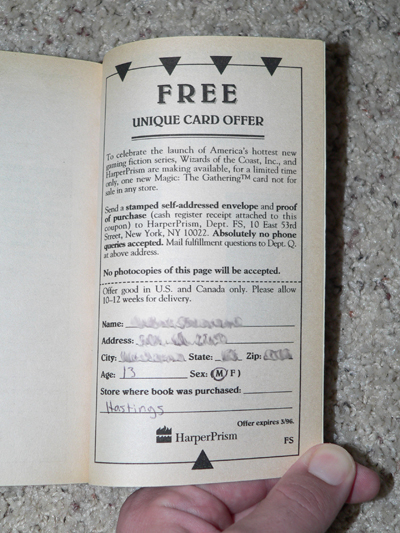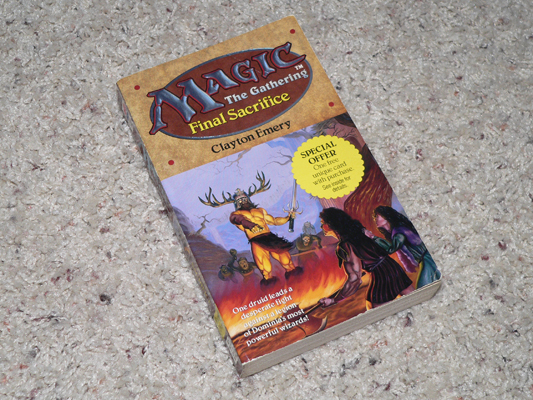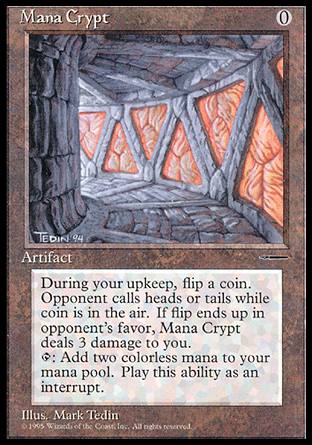In the early years Magic had quite a history with promotional cards.
In the early years Magic had quite a history with promotional cards. Some were special personal promotional cards made specifically for Magic: The Gathering creator Richard Garfield, while others were made for special events. Oh, and of course, there were those cards that you could only get by buying specific Magic: The Gathering novels and sending in a voucher.

In the mid 1990s, the first Magic books came out from the now defunct publisher HarperPrism. As an added bonus, a cut-out voucher was included in the back of five of the first six books that allowed readers to claim a special promotional card through the mail.
Five cards in total were printed with their own special pen-shaped set symbol: Arena, Sewers of Estark, Windseeker Centaur, Giant Badger, and Mana Crypt. These cards were available through five of HarperPrism's first six Magic: The Gathering books - Arena by William R. Forstchen, Whispering Woods by Clayton Emery, Shattered Chains by Clayton Emery, Final Sacrifice by Clayton Emery, and The Cursed Land by Tari McLaren - with the anthology Tapestries (released in July of 1995) being the only one to lack a voucher. Each came with a specific card (with Arena supplying either the Arena or Sewers of Estark card), while the final book, The Cursed Land from Sept. of 1995, reportedly provided readers with one of the five cards that Wizards of the Coast still had left over. Easily the most sought-after of the HarperPrism promos, however, came in the book Final Sacrifice, which released in March of 1995.

While future books were put forward going into 1996, players complained about having to buy the books in order to get the cards. This all but stopped any more of the promotional cards from going out, making the HarperPrism card series a five-and-done product.
In the following years, two of the promotional cards (Giant Badger and Arena) got releases in expansions at one point or another. The underwhelming Sewers of Estark, modern color pie breaking Windseeker Centaur, and the and the rather powerful Mana Crypt were all left without subsequent printings. For more than two decades, the only way players managed to have one of these in their possession is if they had bought The Final Sacrifice and sent in for a card, they got lucky with sending in for a card from The Cursed Land, or they bought or traded for a copy off of a seller or fellow player. Sure, there's the 2011 DCI Judge Promo, but that's not exactly what one would call a widely-available printing.
And it's not like these un-reprinted promo cards are all that bad (Sewers notwithstanding). As for Mana Crypt, it's an artifact that's a zero-drop that taps for two colorless mana. The only real downside is that it has the possibility of dealing three damage to you each turn thanks to its "During your upkeep, flip a coin. Opponent calls heads or tails while coin is in the air. If flip ends up in opponent’s favor, Mana Crypt deals 3 damage to you." rules text.
Finally, in 2016, Mana Crpyt received a relatively widespread release via the Eternal Masters supplemental set. Even then, though, the set had a limited print run and only so many copies of the card made their way into the wild. That's unlikely to change even with the March 13 retail release of WotC's Mystery Booster set thanks largely to the extremely large set size (1,700 cards) and the card having a mythic rarity.
Still, 1995 originals can go for nearly $250 (thanks in part to scarcity and the amazing artwork by Mark Tedin that is absent from the Judge and Eternal Masters versions and even those newer ones go for a couple of Benjamins. The most valuable, however, is the extremely hard-to-find Masterpiece printing from the Kaladesh block, which has a market value of nearly $400.
Not bad for a once nearly-forgotten card that can only see play in two formats: Vintage and Commander.










